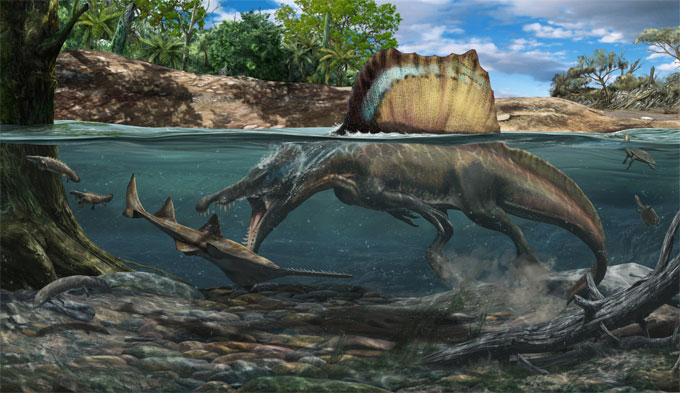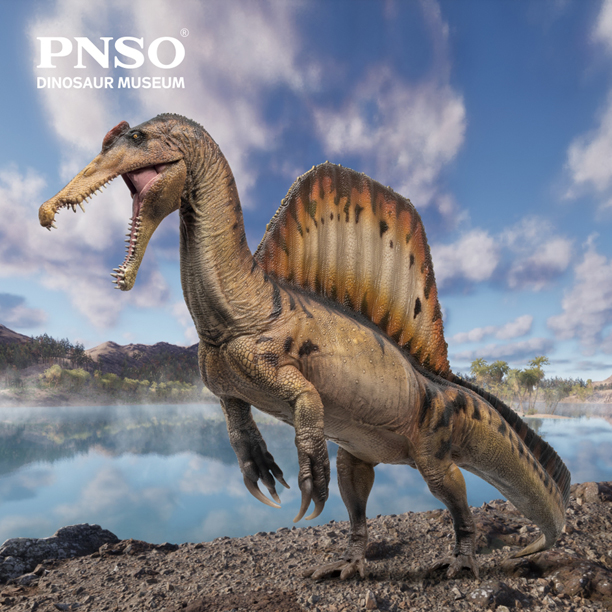The spinosaurids represent an extremely unusual type of theropod. Their mode of hunting and lifestyle remains controversial. Over recent years more fossil material associated with perhaps the most derived spinosaurid Spinosaurus aegyptiacus, has been studied. In addition, new lines of enquiry have been explored in a bid to better understand these bizarre carnivorous dinosaurs. Some scientists have argued that Spinosaurus was a fully aquatic, underwater pursuit predator. Others have argued that this dinosaur stayed in the shallows or waded into the water to catch fish in a similar manner to extant bears.

Spinosaurus aegyptiacus Bone Density Study
Numerous lines of enquiry have been explored in a bid to resolve these questions. A recently published study (Fabbri et al) sought to resolve this matter. They applied a statistical method and explored spinosaurid bone density. Animals like manatees have especially dense bones that enable them to stay submerged. These researchers examined spinosaurid bone density in comparison to the bone densities of extant animals which are adapted to an aquatic life. They concluded that Spinosaurus and its close relative Baryonyx (B. walkeri) were capable of submerging themselves underwater to hunt.
However, newly published research has challenged these conclusions. Scientists from the University of Chicago along with collaborators from the Royal Tyrrell Museum (Canada) and other co-authors have outlined some of the pitfalls in using statistical measurements of bone density to infer a lifestyle. The team identified inconsistencies and they proposed that it was difficult to draw conclusions when taxa are represented by limited data.

The picture above shows the recently introduced PNSO Spinosaurus model. The replica contains a number of anatomical traits identified in contemporary scientific papers. For example, the PNSO Spinosaurus has a broad tail. However, it is depicted as a terrestrial, bipedal animal and not a semi-aquatic quadruped.
To view the range of PNSO prehistoric animals available from Everything Dinosaur: PNSO Dinosaur and Prehistoric Animal Models.
Could Some Spinosaurs Dive?
Writing in the open-access journal “PLOS One” the scientists argue that the previous research was not robust enough to conclude that S. aegyptiacus and Baryonyx walkeri were fully submerged “subaqueous foragers.” Their findings not only invalidate the conclusions of the earlier bone density analysis, but also have important implications for future quantitative uses of bone compactness and discriminant analysis in palaeontology.
To read Everything Dinosaur’s blog post about the earlier research: Bone Density Study Indicates that Some Spinosaurids were Semi-aquatic.
The dense bones found in the relatively short hindlimbs, may have been an adaptation to support the animal’s great weight as it moved on land. The research team, which included Paul Sereno (University of Chicago), propose that Spinosaurus aegyptiacus probably could not dive. Instead, it may have waded in water around two metres deep, without floating. This permitted it to ambush fish with its huge claws and elongated jaws.
The scientific paper: “Diving dinosaurs? Caveats on the use of bone compactness and pFDA for inferring lifestyle” by Nathan P. Myhrvold, Stephanie L. Baumgart, Daniel Vidal, Frank E. Fish, Donald M. Henderson, Evan T. Saitta and Paul C. Sereno published in PLOS One.
The Everything Dinosaur website: Everything Dinosaur.






Leave A Comment